|
|
|
|
|
FoAR 为幸福感而设计:利用面部微表情分析和脑电图生物传感器来评估人类对于二维亲生物几何图形的反应 |
|
|
论文标题:Designing for well-Being: Using facial micro-expression analysis and EEG biosensor to evaluate human responses to 2D biophilically-driven geometries
期刊:Frontiers of Architectural Research
作者:Andrea Macruz , Ernesto Bueno, Gustavo Sol, Jaime Vega, Ricardo Palmieri, Bing Zhao
发表时间:April 2024
DOI: https://doi.org/10.1016/j.foar.2023.11.004
微信链接:点击此处阅读微信文章
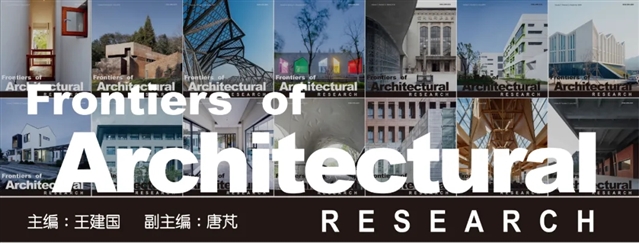
FoAR是由高等教育出版社和东南大学建筑学院联合主办的全英文学术期刊
建筑学 / 城乡规划 / 风景园林
本刊已被 A&HCI / CSCD / Scopus / DOAJ / CSTPCD 收录
Frontiers of Architectural Research(建筑学研究前沿/FoAR)于4月初在线发布了2024年第二期,共12篇文章。本期推送为其中一篇文章的摘要和大纲,内容采用中文表达,方便大家阅读。推文内容不可直接引用。
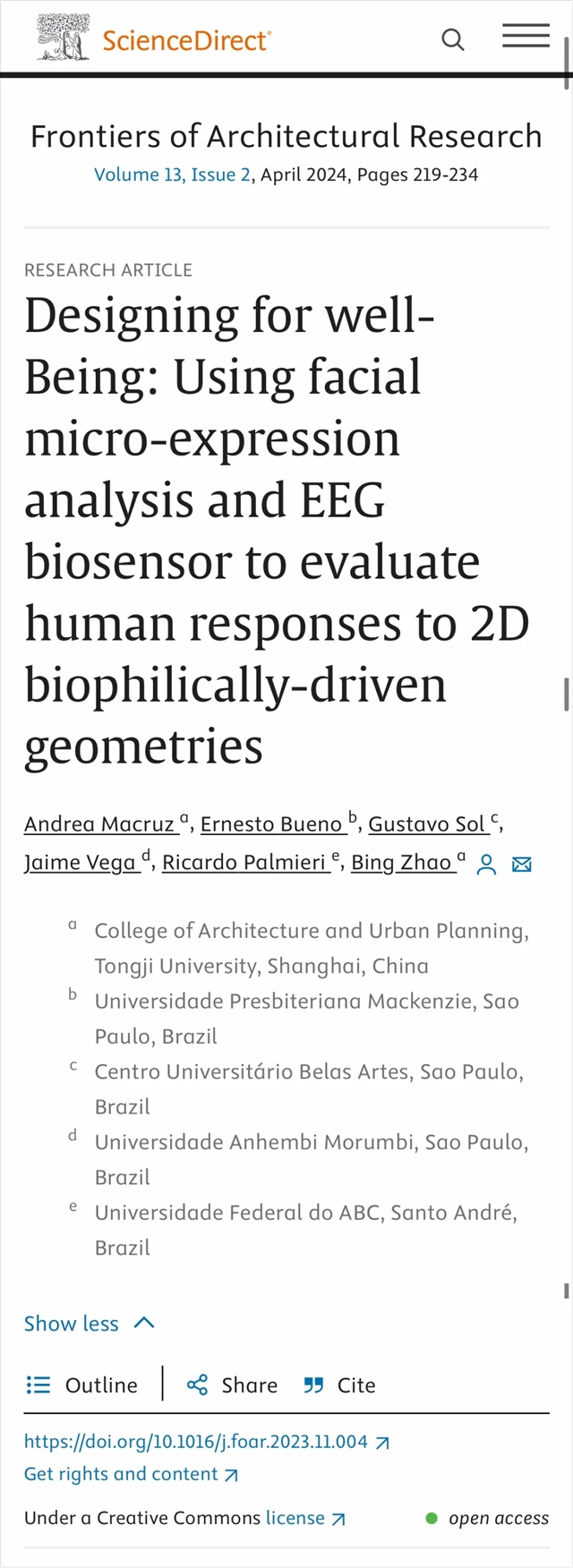
01 论 文 题 目
Manuscript Title
Designing for well-Being: Using facial microexpression analysis and EEG biosensor to evaluate human responses to 2D biophilically-driven geometries
为幸福感而设计:利用面部微表情分析和脑电图生物传感器来评估人类对于二维亲生物几何图形的反应
02 作 者
Authors
Andrea Macruz (a), Ernesto Bueno (b), Gustavo Sol (c), Jaime Vega (d), Ricardo Palmieri (e), Bing Zhao (a)*
(a) College of Architecture and Urban Planning, Tongji University, Shanghai, China
(b) Universidade Presbiteriana Mackenzie, Sao Paulo, Brazil
(c) Centro Universita ?rio Belas Artes, Sao Paulo, Brazil
(d) Universidade Anhembi Morumbi, Sao Paulo, Brazil
(e) Universidade Federal do ABC, Santo Andre ?, Brazil
03 论 文 摘 要
Abstract
This research explores the capacity of emerging technologies to enhance well-being. It involves the generation of 2D biophilically-driven geometries to represent human-response-oriented built environments and conducts inter and intra-individual analyses to assess human responses using a range of technologies within the realms of facial micro- expression analysis and EEG biosensor use. The outcomes of this analysis allow for the grading of these geometries in terms of emotional valences, meditation levels, and subjective preferences. These graded geometries can subsequently be employed in specific architectural contexts, such as interior decor, wallpapers, furniture surfaces, or other architectural and interior components. It is an interdisciplinary effort that underscores the importance of incorporating emerging technological means with human-response-oriented design approaches to foster built environments that promote well-being.
本文探讨了新兴技术在提高人们幸福感方面的能力。主要涉及通过二维亲生物几何图形的生成来代表关于人类反应的建筑环境,以及利用面部微表情分析以及脑电图生物传感器领域内的一系列技术进行人类个体内及个体之间的分析来评估人的反应。本文根据情感价值、冥想水平和主观偏好对所生成的几何图形进行分级并探讨将其应用于建筑环境(如室内装饰、壁纸、家具表皮或者其他建筑或室内构建)的可能。作为一次跨学科的尝试,本研究将新兴技术手段与人类反应导向的设计方法相结合,强调了新技术对于营造幸福感的建筑环境具有重要意义。
04 关 键 词
Keywords
Biophilic design / 亲生物设计
Geometrical algorithmic modeling / 几何算法建模
Facial micro-expression analysis / 面部微表情分析
EEG biosensor / 脑电图生物传感器
Neuroscience / 神经科学
05 章 节 标 题
Sections' Title
1. Introduction / 引言
1.1. Biophilic design: human-response-oriented design strategies to foster well-being / 亲生物设计:为提高人们生活幸福感,以人类反馈为导向的设计方法
1.2. Human responses specifically related to geometries in biophilic design / 亲生物设计中与几何图形相关的人类特殊反馈
1.3. Human responses to biophilia using emerging technologies / 在利用新兴技术过程中人们对亲生物的反馈
1.3.1. Facial micro-expression analysis and EEG biosensor in evaluating human responses to biophilic design / 在评估人们对亲生物设计反馈过程中的面部微表情分析与脑电波生物传感器
1.3.2. Using facial micro-expression analysis and EEG biosensor to evaluate human responses to 2D biophilically-driven geometries / 利用面部微表情分析与脑电波生物传感器来评估人们对2D亲生物驱动的几何图形的反馈
2. Methodology and research process / 研究方法和过程
2.1. Translating biophilic design features into 2D geometries / 将亲生物设计特性转化为二维几何图形
2.2. Incorporating facial micro-expression analysis to understand human responses to 2D biophilically-driven geometries / 结合面部微表情分析来理解人们对于二维亲生物驱动几何图形的反应
2.3. Incorporating EEG biosensor to understand human responses to 2D biophilically-driven geometries / 结合脑电波生物传感器来理解人们对二维亲生物驱动几何图形的反应
2.4. Preference rate: quantitative assessment of geometry preferences / 偏好率:几何偏好的定量评估
2.5. General evaluation of the selection and overall ranking of projects / 对项目选择与排名的总体评估
3. Results / 研究成果
4. Discussion / 探讨
5. Conclusions / 结论
06 主 要 插 图
Illustrations
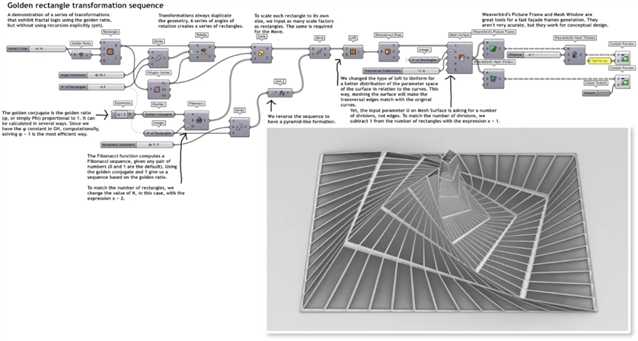
▲ 图一:Example algorithm: geometrical transformation based on the fractal logic of the golden ratio and the Fibonacci sequence, and mesh editions with Weaverbird components。 © 本文作者
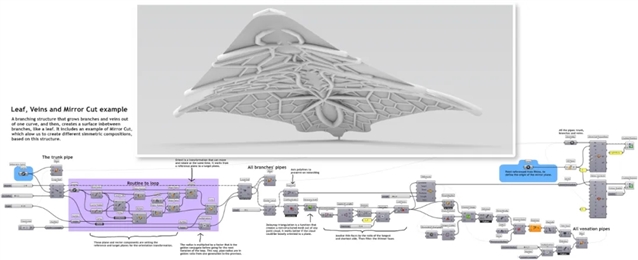
▲ 图二:Example algorithm: geometrical modeling based on transformations and recursive functions。 © 本文作者
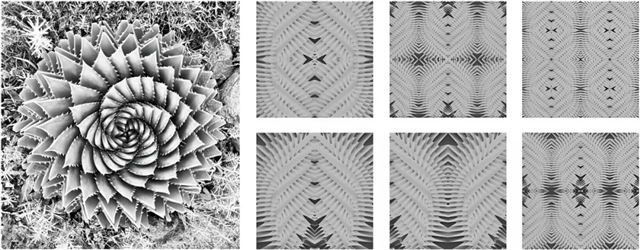
▲ 图三:2D geometries from workshop 01. © Paulo Henrique Dias and Julia Nogueira da Silva, Natural reference and geometric constructions of natural patterns (student work)
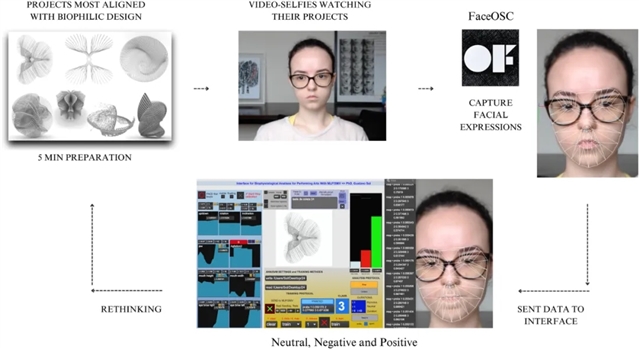
▲ 图四:Workflow of the capture and analysis of facial micro-expression from student Ana Carolina Santos Vicente。 © 本文作者
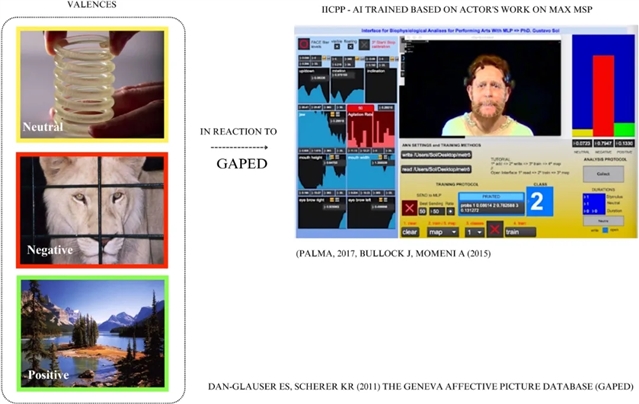
▲ 图五:System trained to correlate and rank facial micro-expressions using GAPED, and to score on positive, neutral and negative emotional valences。 © 本文作者
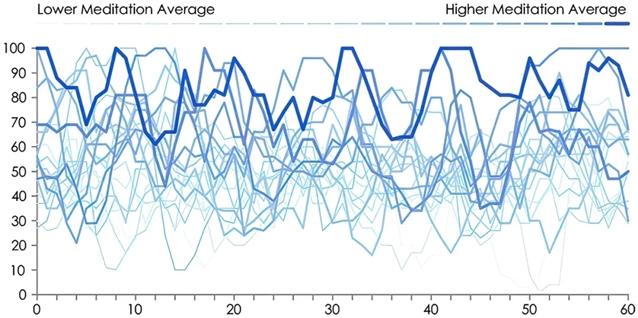
▲ 图六:Graphic plot for average meditation levels (MT) during 60 s of all projects of all workshops。 © 本文作者

▲ 图七:Application of the 2D biophilically-driven geometries as artworks. ©Ingrid Fernandes Baruch (student work)。 本文作者
07 作 者 介 绍
Authors’ Information

Andrea Macruz
Assistant professor
Dubai Institute of Design and Innovation (DIDI)
Ph.D. candidate
College of Architecture and Urban Planning
Tongji University, Shanghai, China
In 2010, Andrea founded a design studio focusing on the study of nature and new technologies, and the work from the studio has been widely published internationally. Besides that, she has a parallel academic career, teaching in architecture and design departments at several universities and institutes, including Abu Dhabi University, Istituto Europeo di Design, and Centro Universitário Belas Artes de Sao Paulo.
Currently, she is an Assistant Professor at the Dubai Institute of Design and Innovation – DIDI (in collaboration with MIT and Parsons) and part of the DigitalFUTURES Ph.D. program at Tongji University in Shanghai.

Ernesto Bueno
MSc Researcher
Universidade Presbiteriana Mackenzie
Sao Paulo, Brazil
Architect, Researcher on digital design methodologies and human-computer interaction in architecture.

Gustavo Sol
Researcher
Universidade Anhembi Morumbi
Sao Paulo, Brazil
Gustavo Sol was born in Ribeirão Preto, São Paulo, in 1975. Actor, director, coach and researcher.Post-PhD Researcher at UFABC at Cognition and Neuroscience Program - Applied Neuroscience Lab, under the supervision of PhD. João Ricardo Sato. Researcher Collaborator at LABORE - Laboratory of Robotics and Rehabilitation, of Federal Institute of São Paulo. PhD in Theatre at University of Sa?o Paulo - ECA/USP (Brazil, 2017). Completed an internship at University Paul Valery Montpellier III (France, 2016). Master in Communication and Semiotics at PUC/SP (Brazil, 2008) and Bachelor in Theatre at State University of Campinas (Brazil, 2000). Previous research investigated Jerzy Grotowski’s concepts mixing them with Brazilian rites. In the performance Discontinuous Object (2013), makes use of an EEG as a brain computer interface to interact with audiovisuals elements in a digital dramaturgical process. Currently, studies the role of sensory feedback and attention in the emergence of emotion in actor’s work using Near Infrared Spectroscopy (NIRS), Electroencephalographic (EEG), Electromyographic (EMG), Heart rate monitor (ECG) and other neuro physiologic and biometric technologies.Loves life, nature, his family, wife, friends, science and arts.

Jaime Vega
PhD Student
Universidade Anhembi Morumbi
Sao Paulo, Brazil
He holds a degree in Architecture and Urbanism from the University of Grande ABC (1999), is a PhD student in Design at the Anhembi Morumbi University where he develops research supervised by Suzete Venturelli, holds a Masters degree in Housing, Planning and Technology from the Institute of Technological Research of the State of São Paulo - IPT/SP (2012), where he developed a line of research in gauging the application of urban legislation and sustainability of the urban built environment.
Desenvolve pesquisas do uso da alta tecnologia em simulações gráficas em realidade virtual e aumentada em seu doutorado, para o uso em projetos em: educação, arquitetura, urbanismo, design e games.

Ricardo Palmieri
Researcher in Innovation and New Medias
Universidade Federal do ABC, Santo Andre, Brazil
Ricardo Palmieri (vj palm), 1978, is a video-jockey and an architect, graduated by the Universidade do Grande ABC (1997-2001), Sao Paulo, Brazil. Currently he is a consultant of space’s development, scenery and interactive installations to artistic and commercial projects using free softwares.
He worked for the Brazilian Ministry of Culture government, inside the program Cultura Viva on the Digital Culture as a researcher of free softwares for graphical production between 2005 and 2007.
Since 2002, he realized works at SESC São Paulo as an independent artist and with the collectives estudiolivre.org http://estudiolivre.org, Metareciclagem and Tempokala performance group. Presented works and workshops in Extremadura University and Hangar in Barcelona (2006), Dubrovinik and Zagreb in Croatia (2008) and Kiberpipa in Ljubliana, Slovenia (2008).
Since then, he is creating electronics devices of low cost and realizing workshops to apply these devices, and plays with his band http://myspace.com/livenoisetupi.

Bing Zhao
Doctoral Candidate
College of Architecture and Urban Planning
Tongji University, Shanghai, China
Bing Zhao is a doctoral candidate at Tongji University’s College of Architectural and Urban Planning in China. She has served as a practitioner in both Los Angeles, USA, and Beijing, China. Additionally, she has worked as an instructor in architectural theory and design studios at the Shanghai Institute of Visual Arts and Hunan University. With a specialization in architectural theory, Bing’s research focuses on the parallelism between swarm intelligence and city formation. She is also interested in neuroscience, complexity science, multi-agent systems, quantum physics, and interdisciplinary research.
08 原 文 阅 读
Download Link

长按上方二维码|浏览本期精彩论文
▼ 点击下方词条 | 往期精彩不容错过
#期刊快讯#系列
1/ 主编王建国院士团队荣获国家科技进步奖一等奖
2/ FoAR|2021年度报告,2022新年快乐!
3/ FoAR|2022年度报告,2023新年快乐!
4/ FoAR|2023年度报告,2024新年快乐!
5/ 最新|FoAR 2022 CiteScore 指数上升为4.7
6/ 2022年度JCR发布|FoAR 首获影响因子 3.5,位列建筑领域期刊第一
7/ 最新|FoAR 被中国科技论文与引文数据库(CSTPCD)收录
8/ 最新|FoAR 再次入选中国国际影响力优秀学术期刊
9/ 最新|FoAR 荣获科爱十大优秀期刊奖
10/ 最新|FoAR进入2023年中国科学院分区表1区
#新刊上线#系列
2024年第一期
2024年第二期
#FoAR投稿指南#系列
1/ 投稿流程
2/ Guide for Author中文版
3/ 审稿流程及发表流程
4/ 如何提交修改稿
5/ 录用文章出版流程
#期刊知识科普#系列
1/ SCI之父尤金·加菲尔德的传奇人生
2/ 国际核心期刊数据库大解析
3/ 手把手教你如何使用最强工具Web of Science
4/ 如何发现一本好期刊
5/ 国内核心期刊有哪些
6/ 版面费与期刊影响力
#精彩文章#系列精选
01/ 城市设计实践发展的多元维度——基于UAL的案例研究
02/ 从智慧城市到共情城市
03/ 传统阿拉伯伊斯兰城市居住区形态学:以传统城市大马士革为例
04/ 建筑遗产预防性保护的意大利视角
05/ 生物与建筑:将科学知识与设计实践相结合的六家法国建筑事务所项目案例研究
06/ 颇具争议的渐进式改造:Elemental建筑事务所金塔蒙罗伊公屋居住区项目的15年
07/ 联合眼动实验和SD法的传统商业街区视觉效果感知评价
08/ 历史的层次:古城堡遗迹中的新建筑改造
09/ 通过空间句法检验帕拉第奥别墅平面中的控制性、中心性和灵活性
10/ 自1931年柯布西耶的Salubra色卡问世后其建筑色彩的偏好:一种跨文化的分析
11/ 建筑师身份的描绘:1920年代末的中国美术建筑师——刘既漂
12/ 探索暴露于风影响下织物的表达与功能
13/ 绿色屋顶能否在地中海气候条件下显著节约能源?基于不同案例的批判性评估
14/ 芬兰近期落成的原木建筑的建构及建筑品质:相关建筑师的解读
15/ 新加坡高校教室光环境品质研究
期刊联络
高等教育出版社: 010-58556484
东南大学:025-83795543
刊物邮箱:foar@pub.seu.edu.cn
FoAR英文期刊交流QQ群:21608832
在线投稿
www.editorialmanager.com/foar
刊物主页
http://www.sciencedirect.com/science/journal/20952635
http://journal.hep.com.cn/foar
《前沿》系列英文学术期刊
由教育部主管、高等教育出版社主办的《前沿》(Frontiers)系列英文学术期刊,于2006年正式创刊,以网络版和印刷版向全球发行。系列期刊包括基础科学、生命科学、工程技术和人文社会科学四个主题,是我国覆盖学科最广泛的英文学术期刊群,其中12种被SCI收录,其他也被A&HCI、Ei、MEDLINE或相应学科国际权威检索系统收录,具有一定的国际学术影响力。系列期刊采用在线优先出版方式,保证文章以最快速度发表。
中国学术前沿期刊网
http://journal.hep.com.cn
特别声明:本文转载仅仅是出于传播信息的需要,并不意味着代表本网站观点或证实其内容的真实性;如其他媒体、网站或个人从本网站转载使用,须保留本网站注明的“来源”,并自负版权等法律责任;作者如果不希望被转载或者联系转载稿费等事宜,请与我们接洽。